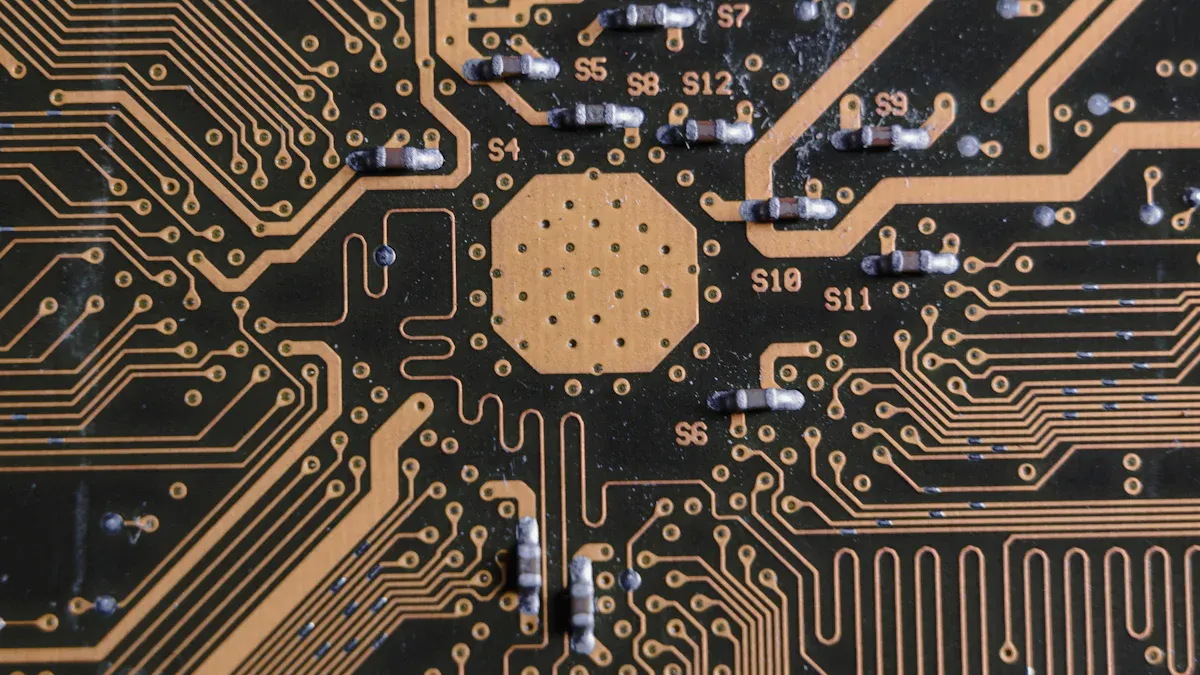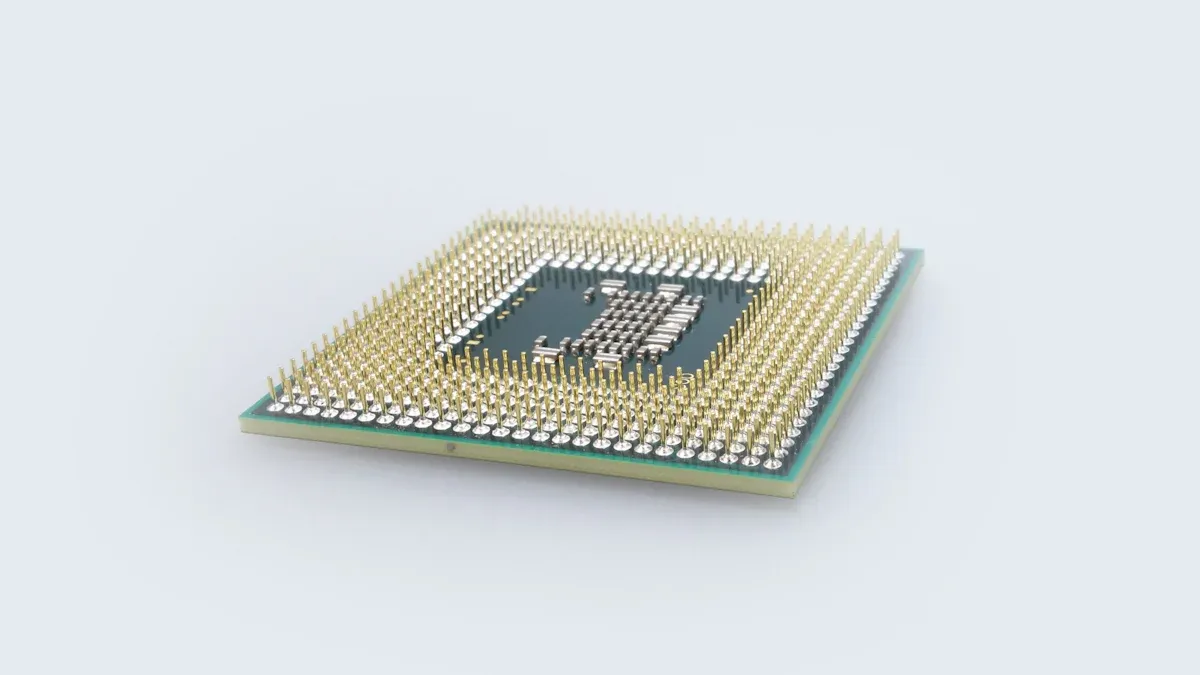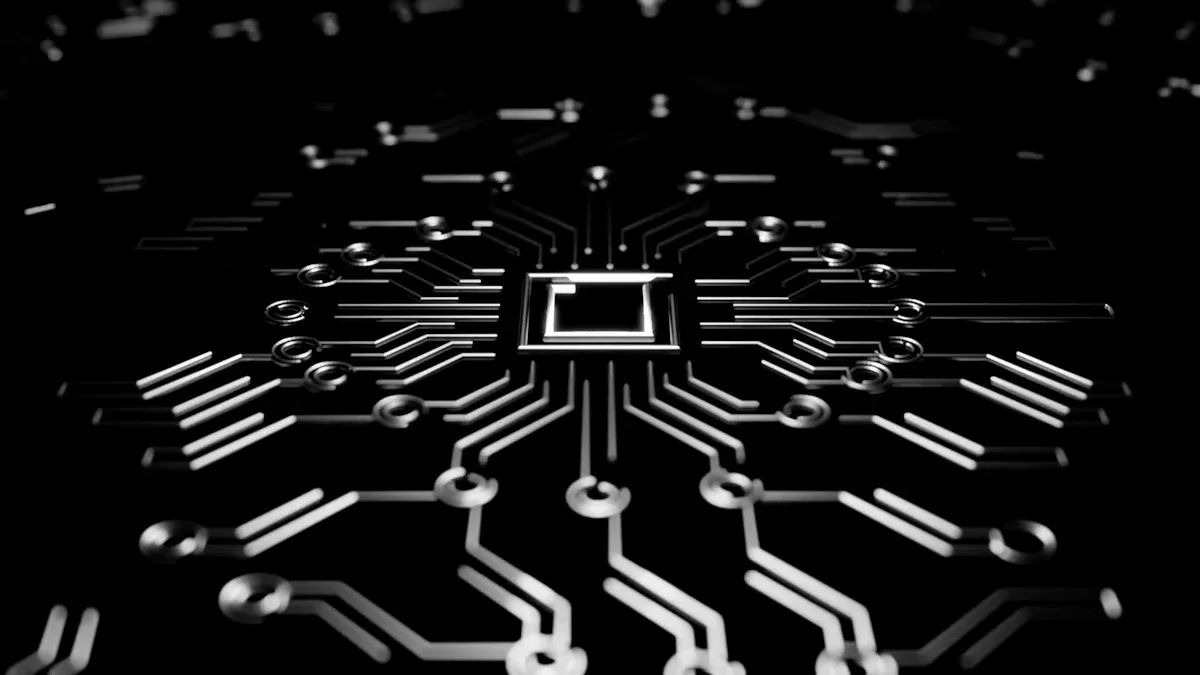What Are System Monitor Chips and How Do They Work

A system monitor chip is a specialized electronic component designed to oversee the health and performance of devices. It tracks key parameters like voltage, temperature, and power usage to ensure everything functions within safe limits. By detecting potential issues early, it helps you prevent system failures and optimize performance. These chips play an essential role in maintaining the reliability of modern electronics, from your smartphone to complex industrial machines. With their ability to manage operations efficiently, they ensure your devices operate smoothly and last longer.
Key Takeaways
System monitor chips check key things like heat and voltage.
They help devices work well and stop them from breaking.
These chips study data to predict problems before they happen.
This helps you fix things early and avoid bigger issues.
Using these chips saves energy, cutting waste and costs.
They make devices last longer and break down less often.
Pick chips that work well in tough environments for best results.
How System Monitor Chips Work

Core functionalities
A system monitor chip performs essential tasks to keep your devices running smoothly. It tracks critical parameters like voltage, temperature, and power consumption. These chips act as the "health monitors" of electronic systems, ensuring that components operate within safe limits.
You can think of them as the brain behind system diagnostics. They detect anomalies, such as overheating or voltage spikes, and trigger corrective actions. For example, if a chip senses excessive heat, it may reduce power output or shut down the system temporarily to prevent damage.
Monitoring mechanisms
System monitor chips use advanced sensors and algorithms to gather and analyze data. These sensors measure physical and electrical properties, providing real-time feedback on system performance.
Here’s how different monitoring mechanisms compare:
Target | Sensor | Sampling Rate | Operating Time | Physiological Relevance |
|---|---|---|---|---|
Development | Cellular Organization | TEER | Daily | |
Function | Acidic Metabolites | Electrochemical | Seconds | 400 s |
Function | Cell Growth | Impedance | 2s | 24 h |
Integrated biosensors deliver immediate updates on media composition.
Electrochemical sensors allow frequent sampling but have shorter operational lifetimes.
Enzyme assay kits can measure glycerol concentration in just five minutes.
These mechanisms ensure that your devices receive accurate and timely information, enabling proactive responses to potential issues.
Integration with system components
System monitor chips seamlessly integrate with other components in your devices. They communicate with processors, memory units, and power supplies to maintain system stability.
For instance, when a chip detects a drop in voltage, it signals the power supply to adjust output. Similarly, if a processor overheats, the chip may instruct cooling systems to activate. This integration ensures that all parts of your device work together harmoniously.
Modern system monitor chips also support communication protocols like I2C and SPI, allowing them to interface with a wide range of hardware. This flexibility makes them suitable for various applications, from consumer electronics to industrial machinery.
Applications of System Monitor Chips

Consumer electronics
You interact with consumer electronics every day, from smartphones to gaming consoles. A system monitor chip plays a vital role in these devices by ensuring they operate efficiently. It monitors temperature, voltage, and power usage to prevent overheating or sudden shutdowns. For example, when you use your smartphone for extended periods, the chip ensures the battery doesn’t overheat by regulating power consumption.
In gaming consoles, these chips help maintain performance during intense gaming sessions. They monitor the system's temperature and activate cooling mechanisms when needed. This ensures your device stays reliable and performs at its best, even under heavy use.
Industrial automation and IoT
In industrial settings, system monitor chips are essential for automation and IoT (Internet of Things) devices. Factories rely on automated machines to perform tasks with precision. These chips monitor the health of machines by tracking parameters like motor temperature and power supply. If a problem arises, the chip can alert you or shut down the machine to prevent damage.
IoT devices, such as smart sensors and connected appliances, also benefit from these chips. They ensure the devices communicate effectively and operate within safe limits. For instance, in a smart thermostat, the chip monitors temperature changes and adjusts the system to maintain comfort while saving energy.
Automotive systems
Modern vehicles depend heavily on electronics for safety and performance. A system monitor chip ensures these electronic systems function properly. It tracks the health of critical components like the engine control unit (ECU), battery, and sensors.
For example, in electric vehicles, the chip monitors the battery's temperature and charge levels. This helps prevent overheating and extends the battery's lifespan. In advanced driver-assistance systems (ADAS), the chip ensures sensors and cameras work reliably, enhancing safety on the road.
By using these chips, automotive manufacturers can deliver vehicles that are not only safer but also more efficient and durable.
Data centers and servers
Data centers and servers form the backbone of modern computing. These facilities handle vast amounts of data and ensure uninterrupted access to digital services. To maintain their efficiency, you need to monitor their performance closely. This is where a system monitor chip becomes invaluable.
These chips track critical parameters like temperature, power consumption, and fan speeds. Servers generate significant heat during operation, and overheating can lead to hardware failure. The chip ensures cooling systems activate when needed, keeping temperatures within safe limits.
Power management is another crucial aspect. A system monitor chip helps optimize energy usage by detecting inefficiencies. For example, it can identify underutilized servers and recommend adjustments to reduce power consumption. This not only saves energy but also lowers operational costs.
You also benefit from enhanced reliability. The chip continuously checks for anomalies, such as voltage fluctuations or hardware malfunctions. When it detects an issue, it alerts you immediately. This allows you to address problems before they escalate, minimizing downtime and ensuring smooth operations.
In large-scale data centers, these chips play a key role in predictive maintenance. By analyzing trends in performance data, they help you anticipate potential failures. This proactive approach reduces the risk of unexpected outages and extends the lifespan of your equipment.
Tip: Regular monitoring with system monitor chips can significantly improve the efficiency and reliability of your data center.
Benefits of System Monitor Chips
Enhanced reliability
A system monitor chip significantly improves the reliability of your devices. It continuously assesses the performance of electronic components throughout their lifecycle. By monitoring for signs of wear or degradation, it helps you anticipate potential failures before they occur. This proactive approach ensures your devices remain operational for longer periods.
These chips also enhance reliability by providing feedback from field failures. Manufacturers use this data to refine their processes and create more robust systems. Over time, this leads to better-performing devices that can handle demanding conditions.
Here are some ways system monitor chips contribute to reliability:
They monitor degradation over time to prevent unexpected breakdowns.
They anticipate adverse events, such as overheating or voltage spikes.
They improve manufacturing processes through insights from real-world usage.
By integrating these chips into your devices, you can enjoy peace of mind knowing they are built to last.
Energy efficiency
Energy efficiency is another key benefit of system monitor chips. These chips optimize power usage by tracking energy consumption in real time. When they detect inefficiencies, they adjust the system to reduce waste. For example, they can lower power output during periods of low activity, conserving energy without compromising performance.
In data centers, where energy costs are a major concern, these chips play a vital role. They identify underutilized servers and recommend adjustments to save power. This not only reduces electricity bills but also minimizes the environmental impact of your operations.
By using system monitor chips, you can achieve a balance between performance and energy savings. This makes them an essential component for sustainable technology.
Predictive maintenance
Predictive maintenance (PdM) is revolutionizing how you maintain your devices, and system monitor chips are at the heart of this transformation. These chips use continuous monitoring to predict when a system might fail. By analyzing data trends, they help you schedule maintenance at the right time, avoiding unnecessary repairs or unexpected downtime.
Industries that require high reliability, such as power plants and transportation systems, have widely adopted PdM. Early fault detection, powered by machine learning and historical data analysis, ensures that issues are addressed before they escalate. This approach aligns with Industry 4.0 principles, enhancing production efficiency and reducing costs.
Here’s how predictive maintenance benefits you:
It minimizes maintenance costs by targeting specific issues.
It reduces downtime, keeping your operations running smoothly.
It optimizes maintenance efforts, saving time and resources.
With system monitor chips enabling predictive maintenance, you can keep your systems in peak condition while maximizing efficiency.
Cost savings
System monitor chips help you save money by optimizing system performance and reducing unnecessary expenses. These chips monitor your devices continuously, ensuring they operate efficiently and avoid costly failures.
Here’s how they contribute to cost savings:
Reduced repair costs: Early detection of issues prevents major breakdowns. Instead of replacing expensive components, you can address minor problems before they escalate.
Lower energy bills: By optimizing power usage, these chips reduce energy waste. For example, they adjust power output during low activity periods, saving electricity.
Extended equipment lifespan: Continuous monitoring minimizes wear and tear. Your devices last longer, reducing the need for frequent replacements.
Note: Investing in system monitor chips upfront can lead to significant long-term savings.
In industrial settings, these chips play a crucial role in minimizing downtime. When a machine stops working unexpectedly, it can disrupt production and lead to financial losses. System monitor chips alert you to potential issues early, allowing you to schedule maintenance during non-peak hours. This proactive approach keeps your operations running smoothly and avoids costly interruptions.
Data centers benefit from these chips by optimizing server usage. They identify underutilized servers and recommend adjustments, helping you reduce operational costs. Additionally, predictive maintenance powered by these chips ensures you spend less on emergency repairs and replacements.
💡 Tip: Use system monitor chips to maximize efficiency and reduce expenses across your devices and systems.
By integrating these chips into your technology, you can achieve significant cost savings while maintaining high performance and reliability.
Challenges and Limitations
Implementation complexity
Integrating system monitor chips into your devices can be a challenging process. These chips require precise calibration to ensure accurate monitoring of parameters like temperature and voltage. If the calibration is off, the chip may provide incorrect data, leading to system inefficiencies or failures.
You also need to consider the design of your device. System monitor chips must fit seamlessly into the existing architecture. This often involves modifying circuit layouts or adding additional components, which can complicate the design process.
Tip: Collaborate with experienced engineers to simplify the integration process and avoid potential pitfalls.
Cost factors
System monitor chips can increase the overall cost of your devices. The chips themselves are not always expensive, but the additional components and design adjustments they require can add up. For example, you might need specialized sensors or enhanced cooling systems to work alongside the chip.
In industries like consumer electronics, where cost efficiency is critical, this can pose a significant challenge. You must balance the benefits of improved reliability and performance against the added expenses.
Key cost considerations include:
The price of the chip and associated components.
The cost of redesigning your device to accommodate the chip.
Long-term savings from reduced maintenance and energy efficiency.
Compatibility issues
System monitor chips must communicate effectively with other components in your device. However, compatibility issues can arise, especially when working with older hardware or proprietary systems.
For instance, some chips rely on specific communication protocols like I2C or SPI. If your device does not support these protocols, you may need to invest in additional hardware or software to bridge the gap.
Note: Always verify the compatibility of the chip with your system before making a purchase. This can save you time and resources during the implementation phase.
Environmental limitations
System monitor chips, like any electronic component, face challenges when operating in extreme environmental conditions. These limitations can impact their performance and reliability, especially in demanding applications.
Temperature is one of the most critical factors. If a chip operates in an environment that is too hot or too cold, it may fail to function properly. High temperatures can cause overheating, leading to reduced accuracy in monitoring or even permanent damage. On the other hand, extremely low temperatures can slow down the chip's response time or cause it to malfunction. You must ensure that the chip operates within its specified temperature range to maintain optimal performance.
Humidity also poses a significant challenge. Excess moisture in the air can lead to condensation on the chip's surface. This can result in short circuits or corrosion of the chip's components. In environments with high humidity, you may need to use protective coatings or enclosures to shield the chip from moisture.
Dust and debris can interfere with the chip's sensors and connections. In industrial or outdoor settings, particles can accumulate over time, reducing the chip's ability to monitor accurately. Regular cleaning or the use of sealed enclosures can help mitigate this issue.
Tip: Always consider the environmental conditions where the chip will operate. Choose chips designed for harsh environments if your application requires it.
Electromagnetic interference (EMI) is another factor to watch out for. Strong electromagnetic fields can disrupt the chip's communication with other components. Shielding techniques, such as using grounded enclosures, can help protect the chip from EMI.
By addressing these environmental limitations, you can ensure that your system monitor chips perform reliably, even in challenging conditions.
A system monitor chip acts as the guardian of your devices, ensuring they operate efficiently and reliably. From tracking temperature and voltage to enabling predictive maintenance, it plays a vital role in modern electronics. You’ll find these chips in everything from smartphones to data centers, where they enhance performance and extend device lifespans. By integrating them, you help advance technology across industries, creating smarter, more sustainable systems. Their ability to optimize operations makes them indispensable in today’s interconnected world.
FAQ
What is the main purpose of a system monitor chip?
A system monitor chip ensures your devices operate safely and efficiently. It tracks key parameters like temperature, voltage, and power usage. By detecting issues early, it helps prevent failures and extends the lifespan of your electronics.
Can system monitor chips work in extreme environments?
Some system monitor chips are designed for harsh conditions. They can handle extreme temperatures, humidity, and electromagnetic interference. Always check the chip's specifications to ensure it suits your application.
Tip: Use protective enclosures or coatings for added durability in challenging environments.
How do system monitor chips improve energy efficiency?
These chips optimize power usage by monitoring energy consumption in real time. They adjust power output during low activity periods, reducing waste. This helps you save energy without sacrificing performance.
Are system monitor chips compatible with older devices?
Compatibility depends on the chip and your device's hardware. Some chips require specific communication protocols like I2C or SPI. Verify compatibility before purchasing to avoid integration issues.
Do system monitor chips require regular maintenance?
System monitor chips are low-maintenance components. However, in dusty or humid environments, you may need to clean or protect them to ensure accurate monitoring. Regular checks can help maintain their performance.
Note: Follow the manufacturer's guidelines for optimal care.
See Also
Understanding Communication Chips And Their Functionality
Exploring Power Supply Chips And Their Operational Mechanisms
Temperature Sensor Chips: Key Characteristics And Functions
Industrial Control Chips: Their Role In Automation Processes
Static RAM Memory Chips: Functionality And Working Principles
